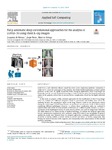Mostrar o rexistro simple do ítem
Fully Automatic Deep Convolutional Approaches for the Analysis of COVID-19 Using Chest X-Ray Images
| dc.contributor.author | Moura, Joaquim de | |
| dc.contributor.author | Novo Buján, Jorge | |
| dc.contributor.author | Ortega Hortas, Marcos | |
| dc.date.accessioned | 2022-03-22T18:57:05Z | |
| dc.date.available | 2022-03-22T18:57:05Z | |
| dc.date.issued | 2022 | |
| dc.identifier.citation | DE MOURA, Joaquim, NOVO, Jorge and ORTEGA, Marcos, 2022. Fully automatic deep convolutional approaches for the analysis of COVID-19 using chest X-ray images. Applied Soft Computing. 1 January 2022. Vol. 115, p. 108190. ISSN 1568-4946. https://doi.org/10.1016/j.asoc.2021.108190. (https://www.sciencedirect.com/science/article/pii/S156849462101036X) | es_ES |
| dc.identifier.issn | 1568-4946 | |
| dc.identifier.uri | http://hdl.handle.net/2183/30142 | |
| dc.description | Financiado para publicación en acceso aberto: Universidade da Coruña/CISUG | es_ES |
| dc.description.abstract | [Abstract] Covid-19 is a new infectious disease caused by severe acute respiratory syndrome coronavirus 2 (SARS-CoV-2). Given the seriousness of the situation, the World Health Organization declared a global pandemic as the Covid-19 rapidly around the world. Among its applications, chest X-ray images are frequently used for an early diagnostic/screening of Covid-19 disease, given the frequent pulmonary impact in the patients, critical issue to prevent further complications caused by this highly infectious disease. In this work, we propose 4 fully automatic approaches for the classification of chest X-ray images under the analysis of 3 different categories: Covid-19, pneumonia and healthy cases. Given the similarity between the pathological impact in the lungs between Covid-19 and pneumonia, mainly during the initial stages of both lung diseases, we performed an exhaustive study of differentiation considering different pathological scenarios. To address these classification tasks, we evaluated 6 representative state-of-the-art deep network architectures on 3 different public datasets: (I) Chest X-ray dataset of the Radiological Society of North America (RSNA); (II) Covid-19 Image Data Collection; (III) SIRM dataset of the Italian Society of Medical Radiology. To validate the designed approaches, several representative experiments were performed using 6,070 chest X-ray radiographs. In general, satisfactory results were obtained from the designed approaches, reaching a global accuracy values of 0.9706 ± 0.0044, 0.9839 ± 0.0102, 0.9744 ± 0.0104 and 0.9744 ± 0.0104, respectively, thus helping the work of clinicians in the diagnosis and consequently in the early treatment of this relevant pandemic pathology. | es_ES |
| dc.description.sponsorship | This research was funded by Instituto de Salud Carlos III, Government of Spain, DTS18/00136 research project; Ministerio de Ciencia e Innovación y Universidades, Government of Spain, RTI2018-095894-B-I00 research project; Ministerio de Ciencia e Innovación, Government of Spain through the research project with reference PID2019-108435RB-I00; Consellería de Cultura, Educación e Universidade, Xunta de Galicia, Spain through the postdoctoral grant contract ref. ED481B-2021-059; and Grupos de Referencia Competitiva, Spain, grant ref. ED431C 2020/24; Axencia Galega de Innovación (GAIN), Xunta de Galicia, Spain, grant ref. IN845D 2020/38; CITIC, as Research Center accredited by Galician University System, is funded by “Consellería de Cultura, Educación e Universidade from Xunta de Galicia, Spain”, supported in an 80% through ERDF Funds, ERDF Operational Programme Galicia 2014–2020, Spain, and the remaining 20% by “Secretaría Xeral de Universidades, Spain ” (Grant ED431G 2019/01). Funding for open access charge: Universidade da Coruña/CISUG | es_ES |
| dc.description.sponsorship | Xunta de Galicia; ED481B-2021-059 | es_ES |
| dc.description.sponsorship | Xunta de Galicia; ED431C 2020/24 | es_ES |
| dc.description.sponsorship | Xunta de Galicia; IN845D 2020/38 | es_ES |
| dc.description.sponsorship | Xunta de Galicia; ED431G 2019/01 | es_ES |
| dc.language.iso | eng | es_ES |
| dc.publisher | Elsevier | es_ES |
| dc.relation | info:eu-repo/grantAgreement/MICINN/Plan Estatal de Investigación Científica y Técnica y de Innovación 2017-2020/DTS18%2F00136/ES/Plataforma online para prevención y detección precoz de enfermedad vascular mediante análisis automatizado de información e imagen clínica/ | |
| dc.relation | info:eu-repo/grantAgreement/AEI/Plan Estatal de Investigación Científica y Técnica y de Innovación 2017-2020/RTI2018-095894-B-I00/ES/DESARROLLO DE TECNOLOGIAS INTELIGENTES PARA DIAGNOSTICO DE LA DMAE BASADAS EN EL ANALISIS AUTOMATICO DE NUEVAS MODALIDADES HETEROGENEAS DE ADQUISICION DE IMAGEN OFTALMOLOGICA/ | |
| dc.relation | info:eu-repo/grantAgreement/AEI/Plan Estatal de Investigación Científica y Técnica y de Innovación 2017-2020/PID2019-108435RB-I00/ES/CUANTIFICACION Y CARACTERIZACION COMPUTACIONAL DE IMAGEN MULTIMODAL OFTALMOLOGICA: ESTUDIOS EN ESCLEROSIS MULTIPLE/ | |
| dc.relation.uri | http://dx.doi.org/10.1016/j.asoc.2021.108190 | es_ES |
| dc.rights | Atribución-NoComercial-SinDerivadas 4.0 Internacional | es_ES |
| dc.rights.uri | http://creativecommons.org/licenses/by-nc-nd/4.0/ | * |
| dc.subject | Pulmonary disease detection | es_ES |
| dc.subject | Covid-19 | es_ES |
| dc.subject | Pneumonia | es_ES |
| dc.subject | X-ray imaging | es_ES |
| dc.subject | Deep learning | es_ES |
| dc.title | Fully Automatic Deep Convolutional Approaches for the Analysis of COVID-19 Using Chest X-Ray Images | es_ES |
| dc.type | info:eu-repo/semantics/article | es_ES |
| dc.rights.access | info:eu-repo/semantics/openAccess | es_ES |
| UDC.journalTitle | Applied Soft Computing | es_ES |
| UDC.volume | 115 | es_ES |
| UDC.startPage | 108190 | es_ES |
| dc.identifier.doi | 10.1016/j.asoc.2021.108190 |
Ficheiros no ítem
Este ítem aparece na(s) seguinte(s) colección(s)
-
GI-VARPA - Artigos [76]






